The Moonlight Gourami, also known as Moonbeam Gourami or scientifically, Trichogaster microlepis, is a strikingly beautiful and peaceful fish species prized for its shimmering silvery-blue colour that mimics the glow of moonlight. This freshwater species, native to Southeast Asia, has a unique allure that captivates both novice and experienced.
This fish species profile showcases a robust creature that thrives in well-maintained tanks mimicking their natural habitat. Providing the right care for your Moonlight Gourami includes proper diet, suitable tankmates, and optimal water conditions, which ensures their health and longevity. This fish makes a fascinating addition to any community aquarium due to its serene demeanour, vibrant coloration, and interesting behaviours.
Table of Contents
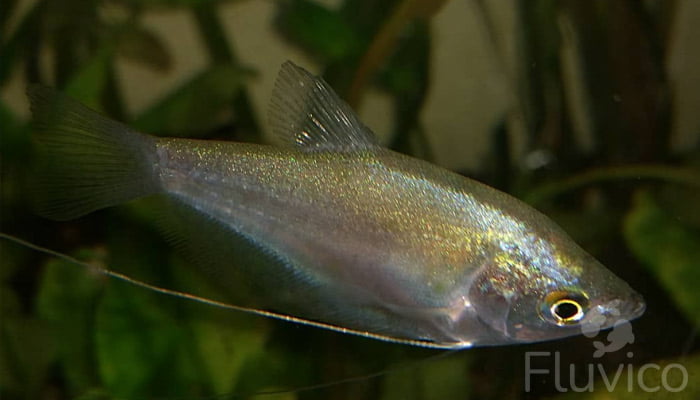
Moonlight Gourami Facts & Overview
| Moonlight Gourami Fact | Details |
| Scientific Name: | Trichogaster microlepis |
| Care Level: | Moderate |
| Native Region: | Southeast Asia |
| Lifespan: | 5-8 years |
| Size: | 4–6 inches |
| Family: | Osphronemidae |
| Diet: | Omnivore |
| Minimum Tank Size: | 30 gallons |
| Compatibility: | Compatible with a variety of peaceful species |
Breed Overview and Characteristics
Native to Southeast Asia, the Moonlight Gourami, scientifically known as Trichogaster microlepis, is an enchanting species highly sought after by aquarists. Revered for its tranquil nature and luminous silver-blue hues reminiscent of moonlight, this species typically grows to a length of 4 to 6 inches.
Part of the Osphronemidae family, the Moonlight Gourami boasts an average lifespan of 5-8 years with appropriate care. As an omnivore, it appreciates a diverse diet.
The ideal habitat is a minimum 30-gallon tank with plenty of hiding spaces, replicating its natural environment. This generally peaceful fish, exhibiting compatibility with a variety of similarly tempered tankmates, is moderately easy to care for, making it a delightful addition to a home aquarium.
One of the most unique and interesting traits of the Moonlight Gourami much like other is its ability to breathe air. Like other members of the Gourami family, they have a special organ called a labyrinth organ. This organ functions much like a lung, allowing them to take in oxygen directly from the air.
This adaptation helps them survive in low-oxygen environments or in waters with poor quality, conditions which are often found in their natural habitat. The ability to gulp air from the surface is not just a survival mechanism but also a regular part of their respiration process, which distinguishes them from many other aquarium fish.
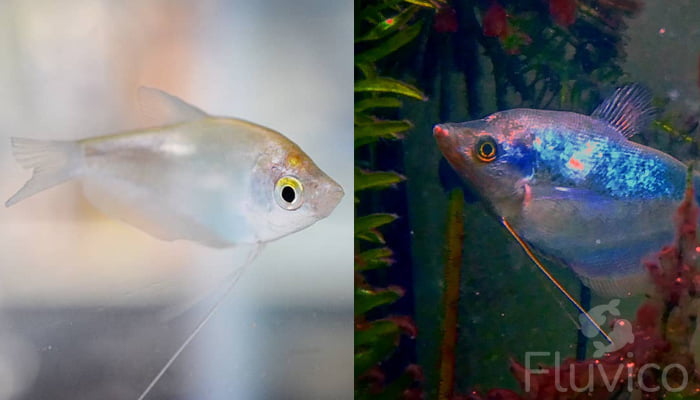
Colours and Markings
The Moonlight Gourami is known for its captivating silvery-blue shade that glimmers under the aquarium light, much like moonlight dancing on a calm lake. Its body displays a streamlined shape with a long, continuous dorsal fin, which is a characteristic trait of the Gourami family.
The most prominent marking is the dark, thread-like pelvic fin, often referred to as “feelers,” that this species uses to navigate its surroundings. Moreover, a faint lateral stripe may appear more visible in some individuals, enhancing their overall allure. The radiant colour and unique markings of the Moonlight Gourami make it a mesmerising sight in any aquarium setting.
Gender Differences
Discerning gender differences in Moonlight Gourami can be a subtle task. Males and females generally share the same silvery-blue hues. However, males are usually more vibrant in colour and have a slightly pointed dorsal fin, whereas females are rounder in body shape and their colours may be somewhat duller.
Additionally, during breeding periods, males develop a darker throat and belly area, making it easier to differentiate them from females. Observing these small but significant differences in physical appearance helps in successful pairing and breeding of this charming fish species in home aquariums.
Setting Up a Suitable Habitat for Moonlight Gourami
Tank Setup
Creating a suitable habitat for your Moonlight Gourami involves mimicking their natural environment, which is typically calm and densely planted.
Here are a few crucial steps for setting up the tank:
- Tank: Opt for one that can hold at least 30 gallons of water. Moonlight Gouramis appreciate space to swim and explore.
- Plants: Incorporate a variety of live ones for them to hide amongst and explore. Floating plants are especially appreciated as they dim the lighting, mimicking their natural habitat.
- Temperature: Ensure the water remains between 22°C-28°C, with a pH of 6.0-7.5, to maintain optimal health and vibrancy.
- Filter: Install one with a gentle flow to keep the water clean without creating strong currents, which could stress the fish.
- Lid: Lastly, provide a secure one, as these fish are known to be excellent jumpers.
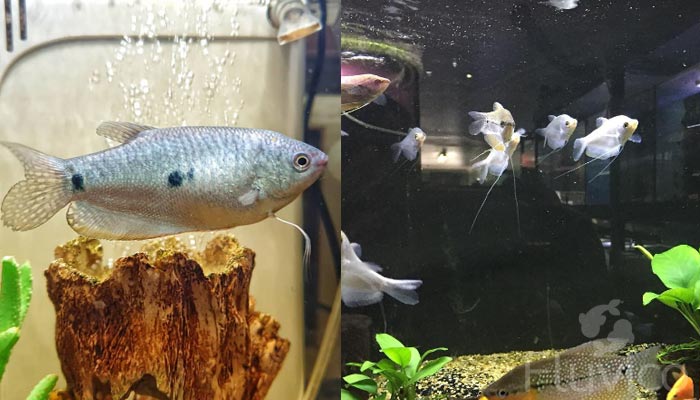
Aquarium Conditions
To maintain the health and vibrancy of Moonlight Gourami, it’s essential to adhere to the following aquarium conditions:
- Water Temperature: Maintain a warm water temperature between 22°C-28°C, mimicking their tropical natural habitat.
- pH Level: Keep the pH level within the slightly acidic to neutral range of 6.0-7.5.
- Hardness: Water hardness should be kept between 4-18 dGH.
- Lighting: Dim to moderate lighting is best, achieved naturally with the use of floating plants.
- Water Flow: A gentle water flow is ideal, as they’re accustomed to calm waters.
- Substrate: Opt for a dark substrate to create a contrasting background, allowing their colours to stand out.
Decoration and Suitable Plants
Decorations
When decorating your aquarium for Moonlight Gourami, you should aim to emulate their natural habitat. Here are a few tips:
- Caves and Hiding Spots: Create plenty of hiding places using rocks, driftwood, or aquarium ornaments. Moonlight Gouramis appreciate secure spots where they can retreat.
- Substrate: Use a dark substrate to contrast beautifully with the Moonlight Gourami’s luminous colour. Sand or fine gravel works well.
Suitable Plants:
- Floating Plants: Moonlight Gouramis love dimmed lighting. Incorporate floating plants such as Duckweed or Amazon Frogbit to provide shade and create a natural, serene environment.
- Tall Plants: Use taller plants like Java Ferns or Amazon Swords at the back and sides of your aquarium. These provide additional cover and also contribute to the overall aesthetic of the tank.
- Broad-Leafed Plants: Broad-leafed plants like Anubias can serve as resting spots for the Gouramis.
Remember, the goal is to create a setting that is both aesthetically pleasing and comfortable for your Moonlight Gourami.
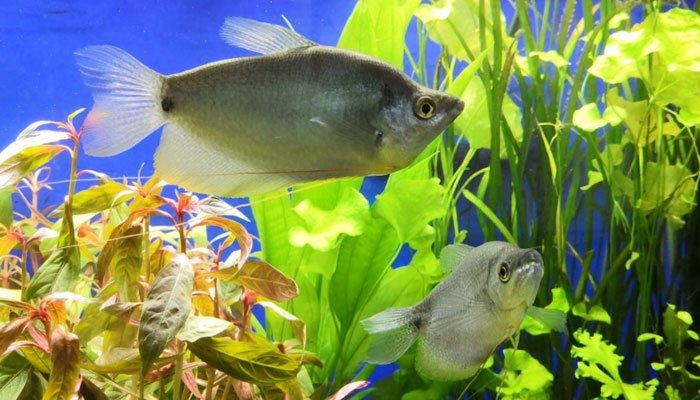
Moonlight Gourami Care
Moonlight Gourami Diet and Feeding
Diet: A healthy Moonlight Gourami diet should include a good quality flake or pellet as a base, supplemented with various fresh, frozen, or freeze-dried foods. These can include bloodworms, brine shrimp, daphnia, and tubifex. Incorporating vegetables like blanched spinach or zucchini is also beneficial.
Feeding Frequency: Feeding them once or twice daily is generally sufficient. However, ensure not to overfeed; a good measure is to only feed what they can consume within 2-3 minutes.
Feeding Tips: Diversify their diet regularly to ensure they receive a wide range of nutrients and to keep them interested in their food. Moonlight Gouramis tend to feed from the middle and top of the water column.
By providing a varied and balanced diet, you can ensure your Moonlight Gouramis maintain optimal health and exhibit vibrant colours.
Suitable Tankmates
Moonlight Gouramis are peaceful fish and can live harmoniously with a variety of tankmates. However, it’s important to choose companions that are similarly peaceful and not overly active or aggressive, as this could stress the Moonlight Gouramis.
Suitable tankmates include:
- Other Gouramis: Dwarf or Honey Gouramis can make good companions, provided the tank is spacious enough to prevent territorial disputes.
- Tetras: Species like Neon Tetras or Rummy-nose Tetras are peaceful and active enough not to intimidate or be intimidated by Gouramis.
- Corydoras Catfish: These bottom dwellers are peaceful and will occupy a different space in the tank, reducing potential conflicts.
- Rasboras and Danios: These species are active, peaceful, and add movement to the upper levels of the tank.
- Peaceful Loaches: Species like Kuhli Loaches or Zebra Loaches can be a good fit.
Avoid housing with aggressive or fin-nipping species, as they can cause unnecessary stress and potential harm to your Moonlight Gouramis.

Moonlight Gourami Diseases
Like all fish, Moonlight Gouramis can be susceptible to various diseases, especially when living in sub-optimal conditions. The two most common diseases they may encounter are Ich and Fin Rot.
- Ich (White Spot Disease): This is a common parasitic disease marked by tiny white spots on the fish’s body, resembling grains of salt. Symptoms also include loss of appetite and lethargy. Treatment usually involves raising the water temperature and using over-the-counter medications.
- Fin Rot: A bacterial or fungal disease that causes the fins to look frayed or discoloured. Early stages can be treated with improved water conditions and commercial medications.
- Dropsy: This bacterial infection is characterized by a bloated body and raised scales. It’s often caused by poor water quality and can be hard to treat, with a focus often on alleviating symptoms and improving tank conditions.
- Velvet Disease: Also known as Gold Dust disease, symptoms include a gold or rusty dusting on the fish’s body, clamped fins, loss of appetite, and lethargy. It’s usually treated with a combination of medication and darker tank conditions.
- Swim Bladder Disease: This condition affects the fish’s ability to control its buoyancy, leading it to float at the top or sink to the bottom. It can be caused by various factors such as overfeeding, sudden changes in water temperature, or bacterial infection.
Prevention is always the best approach to diseases. Maintain a clean tank, provide a balanced diet, and ensure optimal water conditions. If you notice any unusual behavior or physical changes in your Moonlight Gourami, it’s important to act quickly and consult with a fish health professional.
Moonlight Gourami Iridovirus
Iridovirus, also known as Dwarf Gourami Disease (DGD), is a viral illness that can potentially affect Moonlight Gouramis, despite its name suggesting it primarily impacts Dwarf Gouramis.
The symptoms of Iridovirus can include lethargy, loss of color, reduced appetite, the development of sores or cysts, bloating, and the gradual wasting away of the fish’s body. It’s thought to be spread primarily through the introduction of an infected fish into the tank, and the disease can have a high mortality rate.
It’s always recommended to buy fish from reputable sources and quarantine new arrivals before introducing them into your main aquarium to reduce the risk of disease spread. Regularly monitoring your fish for any behavioral or physical changes can also aid early detection. If you suspect Iridovirus, isolate the affected fish immediately to prevent it from spreading to others, and consult with a fish health professional for further advice.
Regrettably, in cases where a cure is unattainable, humane euthanasia is often the most compassionate course of action for the suffering fish, and it serves as a necessary measure to prevent the disease from spreading further.
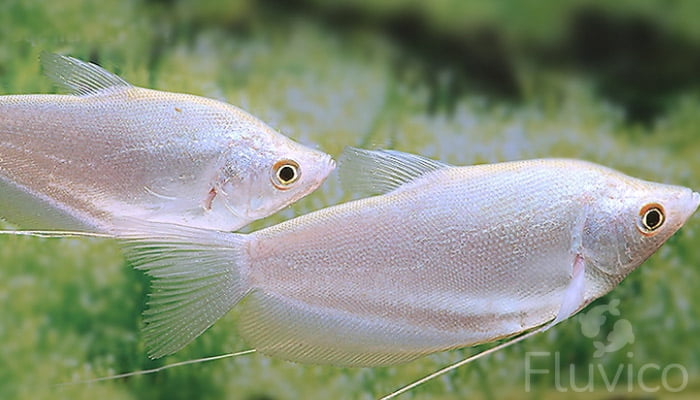
Breeding Moonlight Gourami
Step by Step guide to Breeding Moonlight Gouramis
Identify a Pair:
Look for a healthy pair of male and female Moonlight Gouramis. The males are generally more vibrantly coloured and have a pointed dorsal fin, while the females have a rounder body shape and slightly duller coloration.
Set Up a Breeding Tank:
Prepare a separate tank with shallow water (around 8-10 inches deep), a temperature of about 28°C, and a pH level of 6.0-7.0. Add a few floating plants to help the male build a bubble nest.
Condition the Pair:
Feed the identified pair a diet rich in protein (like live or frozen brine shrimp or bloodworms) for a few weeks to trigger spawning.
Introduce the Pair:
Once conditioned, introduce the pair to the breeding tank. The male will start to build a bubble nest amongst the floating plants.
Watch for Spawning:
If the female is receptive, she will swim under the bubble nest and begin the spawning process. The male will wrap his body around the female, who then releases eggs for the male to fertilize.
Post-Spawning Care:
After spawning, the male will place the eggs in the bubble nest. At this point, remove the female from the tank, as the male will become aggressive in his protection of the nest.
Monitor the Eggs:
Over the next few days, keep an eye on the eggs. The male will guard the nest and retrieve any falling eggs.
Caring for Fry:
Once the eggs hatch (usually in 24-36 hours), remove the male from the tank to protect the fry. Feed the fry with infusoria or commercially available fry food until they are large enough to eat brine shrimp nauplii or micro-worms.
Patience and attentiveness are key when breeding Moonlight Gouramis.

Magnificent Moonlights
The addition of Moonlight Gouramis can enrich the ambiance of your aquarium, offer a peaceful coexistence with other tank mates, and provide hours of captivating observation for the aquarist. Here are a few compelling reasons why you should:
- Striking Aesthetics: Moonlight Gouramis showcase a luminescent, silvery-blue body, adding an enchanting touch to any tank.
- Peaceful Nature: Known for their calm and peaceful disposition, these fish are unlikely to cause or engage in conflict, making them an ideal choice for community tanks.
- Engaging Behavior: These fish are active swimmers and have fascinating behaviors to observe, such as building bubble nests and using their pelvic “feelers” to explore their surroundings.
- Adaptability: Moonlight Gouramis are quite hardy and can tolerate a range of water conditions, making them a suitable choice for beginners or those with less-than-perfect water conditions.
- Breeding Opportunities: If the captivating process of fish breeding interests you, start with Moonlight Gouramis. Their unique bubble nest building habits make them an excellent choice.
- Compatibility: Compatible with peaceful, similarly-sized fish, they help create a diverse, harmonious aquatic community.
FAQ
How many Moonlight Gouramis should be kept together?
Moonlight Gouramis are peaceful and can be kept in pairs or small groups. However, ensure your tank is large enough to prevent territorial disputes – a 30-gallon tank can comfortably house a pair or trio.
Can 3 male Gouramis live together?
While Moonlight Gouramis are generally peaceful, housing three males together could potentially lead to territorial disputes, especially in smaller tanks. If attempted, a large tank with ample hiding spots is necessary to mitigate aggression.
How big do Moonlight Gouramis get?
Moonlight Gouramis typically grow to a size of 4 to 6 inches (10-15 cm) in length when kept in optimal conditions in a home aquarium.
Why is my Moonlight Gourami not eating?
A Moonlight Gourami might stop eating due to stress, poor water conditions, illness, or a diet that lacks variety. It’s crucial to assess tank conditions, check for signs of disease, and ensure dietary diversity.
why is my Moonlight Gourami laying on its side?
If your Moonlight Gourami is laying on its side, it may be a sign of stress, poor water conditions, or illness such as swim bladder disease. Immediate action should be taken to identify and rectify the cause.
More Reading

15 Types of Cryptocoryne: Which is Best For Your Aquarium Setup?

16 Awesome Low Light Aquarium Plants (Mosses, Ferns & Stem Plants)


18 Types of Aquarium Moss: Photos, Care, Propagation & Growth Guide
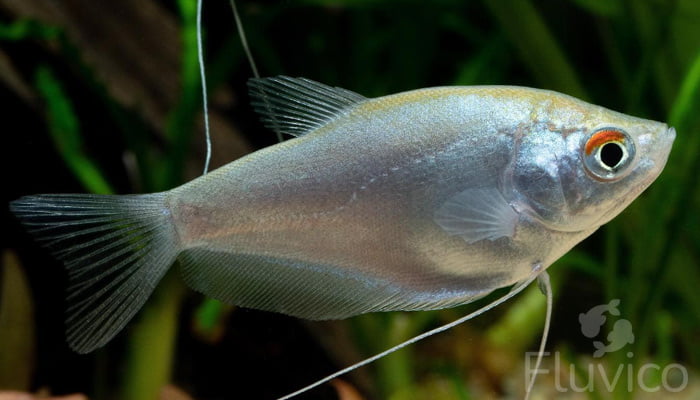
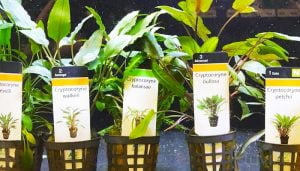
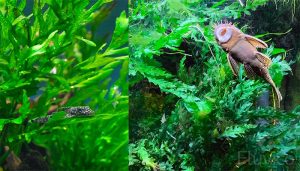



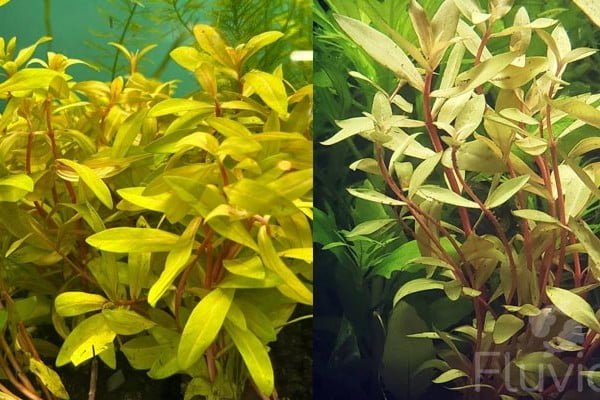
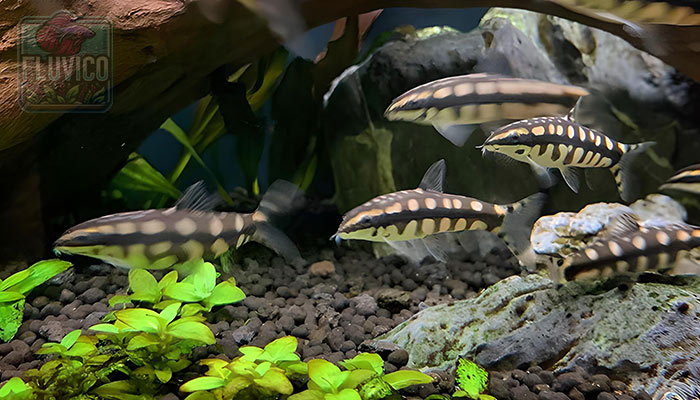

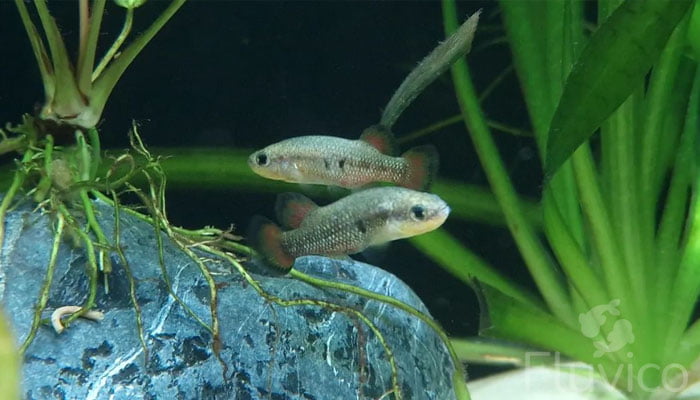
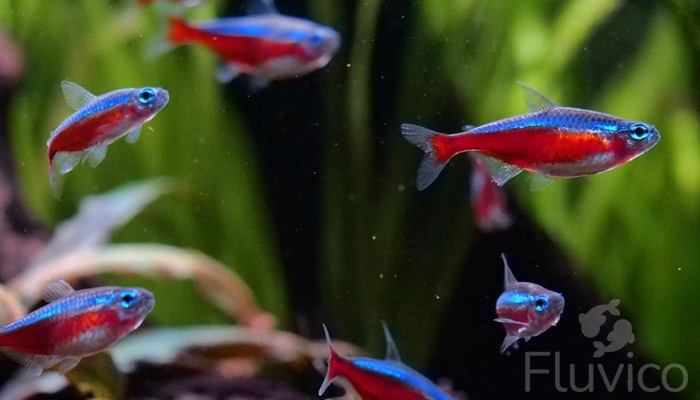
Hope you enjoyed our Moonlight Gourami Care Guide!
If you have any questions? Ask away, we’re here to help!
All the best,
Daniel